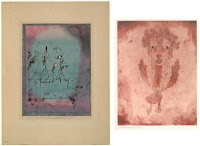http://painting.about.com/od/artglossaryb/g/defBraque.htm http://www.artcyclopedia.com/artists/braque_georges.html
The artist named this period of his creativity to be "really a picturesque fairy tale". During the war-time period because of the shortage of materials the formats of his pictures become ever less, up to that moment when the artist was compelled to be content with gouache painting on cardboards of a small format.
http://www.ibiblio.org/wm/paint/auth/kandinsky/
http://www.artlamp.com/Kandinsky.htm
http://www.kirjasto.sci.fi/kandinsk.htm
http://cgfa.sunsite.dk/kandinsky/kandinsky_bio.htm
http://www.artcyclopedia.com/artists/marc_franz.html
http://www.csa.com/discoveryguides/marc/overview.php
 1914
1914Marsden Hartley
“I am not a ‘book of the month’ artist and do not paint pretty pictures; but when I am no longer here my name will register forever in the history of American Art and so that’s something too.” — Marsden Hartley
http://www.walkerart.org/uia-bin/uia_query.cgi/sort_by/creator/wbibliography/key/487
http://www.glbtq.com/arts/hartley_m.html
 Alexander Archipenko
Alexander ArchipenkoIt is generally agreed that Archipenko did his best work between 1910 and 1920. He was so dexterous that much of his sculpture appears facile. This is particularly true of his later work, in which he often appears to be straining for novelty and effect. For instance, in 1924 he started using motors to cause parts of the sculpture to move; he called this genre "Archipentura." His later sculpture is more complicated and decorative, and he seems to have been distracted by superficialities such as color.
http://www.bookrags.com/wiki/Alexander_Archipenko
 1916
1916Jean (Hans) Arp
His sculpture in the round, like the wooden reliefs, is curving and vaguely suggests the world of nature, such as hills, clouds, or part of a torso, rather than the world of machines. Arp always brought his material, the stone or bronze, to a high degree of finish. He described his sculpture as "concretions." "Concretion," he wrote, "designates solidification, the mass of the stone, the plant, the animal, the man. Concretion is something that has grown."
http://www.poemhunter.com/jean-hans-arp/resources/
http://sdrc.lib.uiowa.edu/dada/dadas/arp.htm
http://www.abcgallery.com/A/arp/arpbio.html
http://www.biography.com/search/article.do?id=9382980
http://www.answers.com/topic/jacques-lipchitz
http://www.jacques-lipchitz.com/
1918
Max BeckmannBeckmann's style in the immediate postwar period appears to have been affected primarily by German Gothic art. Its compressed space was well suited to his increasingly philosophical and poetic compositions. The powerful color and roughhewn forms of the Gothic also appealed to Beckmann. Among the paintings of this period the most important is Night (1918-1919).
http://www.guggenheimcollection.org/site/artist_bio_15.html
http://en.wikipedia.org/wiki/Max_Beckmann
Léger served in the military from 1914 to 1917. His “mechanical” period, in which figures and objects are characterized by tubular, machinelike forms, began in 1917. During the early 1920s he collaborated with the writer Blaise Cendrars on films and designed sets and costumes for performances by Rolf de Maré’s Ballets Suédois; in 1924 he completed his first film, Ballet mécanique, which was neither abstract nor narrative but a series of seemingly unrelated images (a woman’s teeth and lips, machines, ordinary objects, and routine human activities).
http://en.wikipedia.org/wiki/Fernand_L%C3%A9ger
http://www.rogallery.com/leger_fernand/leger-biography.htm
http://artchive.com/artchive/L/leger.html
Exposed at this exhibition to the work of such artists as Vincent van Gogh and Pablo Picasso, Davis became a committed "modern" artist and a major exponent of cubism and modernism in America.
http://en.wikipedia.org/wiki/Stuart_Davis_(painter)
Major Klee exhibitions took place in Bern and Basel in 1935 and in Zurich in 1940.
http://www.moma.org/collection/browse_results.php?object_id=37347
http://en.wikipedia.org/wiki/Paul_Klee
In 1913 Gabo went to Paris to see Pevsner, who had a studio there and who introduced him to friends involved in the modern movement in art. Gabo and Pevsner went to Oslo after World War I was declared, and there, in 1915, Gabo made his first sculptures. These pieces were cubist. He used sheet metal and celluloid to build abstract likenesses of human beings; one example is his Head of a Woman (1916), composed of opaque celluloid cut, bent, and attached to a flat plane to become a high relief extending from a flat surface.
http://www.answers.com/topic/naum-gabo
http://www.askart.com/AskART/artists/biography.aspx?artist=70873
http://www.leninimports.com/naum_gabo.html
Samuel John Peploe (27 January 1871 - 11 October 1935) was a Scottish Post-Impressionist painter, noted for his still life works and for being one of the group of four painters that became known as the Scottish Colourists.
http://en.wikipedia.org/wiki/Image:Peploe,_Still_life_-_apples_and_jar.jpg
Weston had his own portrait studio in Tropico, California and also began to have articles published in magazines such as American Photography, Photo Era and Photo-Miniature where his article entitled "Weston's Methods" on unconventional portraiture appeared in September, 1917.
http://www.bookrags.com/wiki/Edward_Weston
http://en.wikipedia.org/wiki/Edward_Weston
http://www.photo-seminars.com/Fame/EdWeston.htm













No comments:
Post a Comment